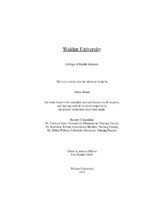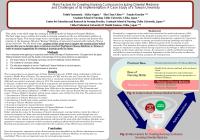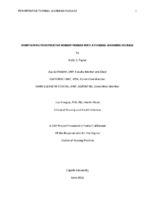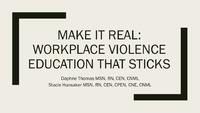Browsing by Title
Now showing items 8710-8729 of 15108
-
The magic and misery of telemetry...at end-of-life
Telemetry and Intensive Care unit beds are in demand, thus, utilization are often lean. Thus, these patient are critically ill & futile outcome, but family wants everything done. These patients remain on medical-surgical ... -
Magnesium sulfate effectiveness for ERAS Protocols
Magnesium sulfate has been considered a versatile anesthetic adjunct in the past, though its analgesic potential remains controversial. The discovery of its ability to block the N-methyl-D-aspartate receptor in the central ... -
Magnesium sulfate in relation to preeclamptic postpartum mothers
Magnesium sulfate is often used from the onset of labor and during the postpartum period to stabilize maternal blood pressure. Because little is known about magnesium sulfate, there is a concern that allowing mothers to ... -
Magnet facility nurses: Pursuing a baccalaureate degree in nursing
(2016-03-21)Session presented on Saturday, November 7, 2015 and Sunday, November 8, 2015: Background: In Future of Nursing (2011), the Institute of Medicine (IOM) concluded that nurses should be prepared at the baccalaureate level. ... -
The Magnet journey: Understanding the role of unit culture in evidence-based practice adoption
Purpose: The purpose of this exploratory study was to identify salient cognitive beliefs and cultural assumptions that affect the emergence and maintenance of evidence-based practice (EBP) in the hospital setting. Scope: ... -
A Magnet system implementation of the Hester Davis Fall Reduction Program
A Magnet-recognized academic hospital system experienced an increase in patient falls and patient falls with injury after transitioning to a new electronic health record. The purpose of the project was to evaluate the ... -
The ‘magnetic forces’ of Swiss acute care hospitals: A secondary data analysis on nurses׳ job satisfaction and their intention to leave their current job
(Elsevier, 2016)Increasing nurse shortages and accelerating personnel turnover are global healthcare issues. Improving nurses׳ job satisfaction and reducing their intentions to leave are crucial to nurse workforce stability. -
Magnet® tea: The journey of a publication steeped in Magnet values
Shortly after the initial Magnet® designation of a 700+ bed not-for-profit Level One Trauma Center, a Clinical Nurse Educator identified a need to involve bedside nurses in research and evidence based practice (EBP). ... -
Main factors for creating a nursing curriculum including Oriental medicine and challenges of its implementation: A case study of a Japanese university
(2016-03-21)Session presented on Monday, November 9, 2015 and Tuesday, November 10, 2015: Background: Prompted by a suggestion in the model core curriculum for medical education in 2001, all medical faculties and university hospitals ... -
Main factors for creating a nursing curriculum including Oriental medicine and challenges of its implementation: A case study of a Taiwan university
(2016-03-21)Session presented on Monday, November 9, 2015 and Tuesday, November 10, 2015: Background: Prompted by a suggestion in the model core curriculum for medical education in 2001, all medical faculties and university hospitals ... -
Maintaining emergency room nurse momentum to screen for substance use
(2016-03-17)Session presented on Sunday, July 26, 2015: Purpose: Substance use is a worldwide public-health priority. Annually, 2.5 million die from the harmful use of alcohol (World Health Organization (WHO) 2011 Global Status ... -
Maintaining peiroperative normothermia with a thermal warming package
Perioperative normothermia must be maintained to safeguard the colorectal patient from development of postoperative surgical site infections (SSIs). Colorectal patient hypothermia throughout the perioperative period was ... -
Maintaining resiliency through the COVID-19 experience
This session will focus on the resiliency of the world’s nursing workforce. The COVID-19 experience brought challenges to nurses everywhere, often resulting in a decrease in the resiliency of nurses in all venues of ... -
Maintaining yoga practice for diabetes control and prevention
BACKGROUND: Type 2 diabetes mellitus affects millions of individuals, representing a vast burden of disease for the national health care system. Yoga practice has demonstrated potential for diabetes control and prevention, ... -
Maintenance COPD medication to reduce readmissions and improve quality of life
(2017-09-20)Purpose: This study examines COPD patients’ quality of life after using maintenance inhaler for one year and investigates the effects of maintenance COPD therapy related to exacerbation-related hospital readmission ... -
Major US hurricanes: A comparative analysis of victim experiences utilizing transcultural and behavioral models
Vulnerable populations risk poor outcomes during disasters. A content analysis compared victim experiences from hurricanes Katrina, Matthew, Florence, and Michael. The Giger and Davidhizar Transcultural Assessment Model ... -
Make It Real: Workplace Violence Education That Sticks!
It is known that education is necessary to prepare nurses with the knowledge, skills, and confidence to prevent and respond to situations involving workplace violence (WPV), but how can we make education effective in order ... -
Making a case for innovations in learning: Overcoming resistance in nursing education
This will be part 3 of 3 sessions that explore game-based learning in nursing education. Whether game-based learning or another type of educational innovation, there can be resistance to change! In this session we will ... -
Making a cross-country comparison of health systems: What are the possible study design frameworks?
(2017-07-03)Purpose: Health care systems form the framework and context through which countries provide health care services to their populations. They are comprised of an amalgam of culturally- and often economically-driven structures ... -
Making a difference with chapter philanthropy
(2012-11-29)Session presented on Thursday, September 20, 2012: What do you want to change or strengthen about nursing and health care in your community? Attend this chapter panel presentation to hear best-practices in chapter service ...



















